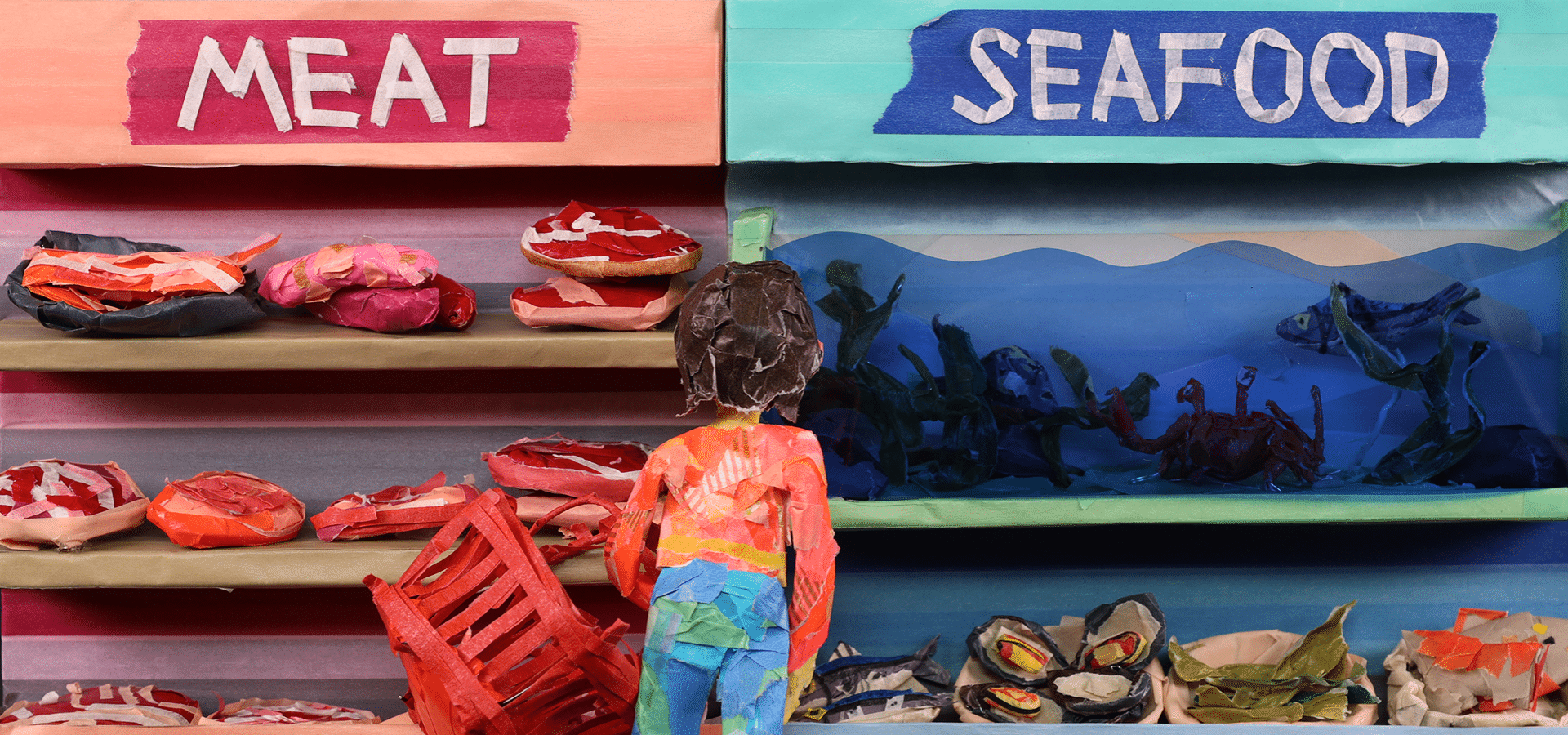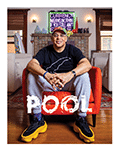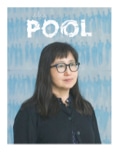The island of trash floating upon the sapphire seas between California’s coastline and Hawaii has swelled to perhaps twice the size of Texas, and that’s a conservative estimate. This garbage-strewn oceanic gyre is a symbol of our fraught relationship with the environment, and its constant growth seems inevitable. At current pollution rates, plastic will outweigh all the fish in the ocean by 2050 according to a report from the Ellen MacArthur Foundation in partnership with the World Economic Forum.
Though the ocean and our relationship with it are difficult to conceptualize—out of sight, out of mind—the consequences are clear: The Center for International Environmental Law found that microplastics, or plastic fragments less than 5 millimeters in length, accelerate greenhouse gas production and interfere with the ocean’s ability to absorb carbon dioxide. Such harm is exacerbated by global industries continually plundering its depths and choking the water with oil and other pollutants.
But in CalArts classroom A112D, artists are working to forge a greener future. CalArts Collaborates, a yearlong studio course centered on nonprofit collaboration, has partnered with the World Resources Institute (WRI) this academic year to fight the global climate crisis through the oceans.
As its name suggests, the class is also collaborative at the Institute level—students from the Graphic Design Program and the School of Film/Video programs were divided into four teams. Consequently, the class was taught by Yasmin Khan Gibson, director of the Graphic Design Program, and Maureen Furniss, director of the Experimental Animation Program.
“We changed the original concept, which was to make one-minute animated films and do graphic design-related projects,” said Furniss. “In the end, it grew into a bigger, looser organization.”
Throughout the year, WRI scientists, designers, and creative directors offered students research materials and guidance by both video conference and campus visits. Each team was given access to synopses of forthcoming WRI white papers (fittingly titled “Blue Papers”) and charged with selecting their topics from issues identified in the research.
“The most surprising thing about this project has been a realization on the part of both the faculty and the students of the value of art and design in allowing an audience to access these overwhelming global problems at a human scale,” said Khan Gibson.
The students’ research and multidisciplinary approaches culminated in a diverse series of projects targeted to a global audience of future leaders and their families: habit-changing apps, culture jamming campaigns, educational short films, and sustainable apparel lines. “I knew nothing about animation, so it’s been cool to get an inside look into what you do,” graphic designer Makena Janssen (Art MFA 22) told her teammate, animator Yoo Jung Hong (Film/Video BFA 22), while speaking of her experience in the course. “It’s been fun working together, too.”
And it’s not just the students who cited the benefits of working with artists from other disciplines—Furniss and Khan Gibson also noted the rewards of co-teaching with different artistic backgrounds.
“The way she thinks about things and the way I think about things are complementary but different,” said Furniss. “I’d listen to Yasmin and think, ‘That’s a great way to solve that problem.’”
Khan Gibson turned to her with a smile. “Absolutely, I’ve had the same experience.”

Indigarb
Upcycled and reconstructed apparel
The modern fashion industry is notorious for quickly cycling through trends, leaving last season’s looks to gather and waste on a gargantuan scale.
In recent years, concerns about the unsustainable nature of the fashion industry, “fast fashion” in particular, have entered the mainstream. To combat the environmental costs of the fashion world, Lorelei Acuña (Film/Video BFA 22) and Avery Jagre (Art BFA 20) have crafted a plan to mobilize the art and design community through their project “Indigarb.”
“The fashion industry is the second-largest polluter in the world after the oil industry, which is why we’re interested in sustainability, upcycling, and creative reuse,” said Jagre. This statistic is validated by a November 2018 article by the United Nations Environment Programme, which found that the textile industry is responsible for 10 percent of global carbon emissions and 20 percent of global wastewater, requiring an astounding 2,000 gallons of water to produce a single pair of denim jeans.
“The fast fashion industry just keeps producing more clothes, but not using what we already have,” said Acuña.
Growing interest in “upcycling” (recycling and retailoring) garments reflects a desire among youths to be more socially conscious in their sartorial choices and to look stylish doing so. Acuña and Jagre pointed to fashion DIY influencer Amber Scholl and rapper Princess Nokia as public figures who promote sustainable fashion practices. Scholl, who went viral in 2018 for making a prom dress made entirely out of trash bags, primarily crafts and shares trendy looks with her 3 million-strong YouTube audience. Princess Nokia’s style falls more in line with the streetwear aesthetic, exemplified on her track “Balenciaga,” a jaunty ode to thrifting: “Whole fit lit, it cost me nada.”
“Indigarb” contributes to the movement with a line of upcycled and reconstructed apparel: flowing layered trench coats, cellophane-esque mermaid skirts, vibrant slouchy sweats, and fishnet tote bags created from Acuña and Jagre’s colorful multi-texture concept designs. Several of the pieces were adorned with hand-painted lettering and given a splash of color with natural dyes, such as hibiscus. Through their wide-ranging pieces, the pair offer outfits for lounging at the beach, traversing the city streets, or strutting down the catwalk.
“We don’t want anyone to feel ashamed or guilty,” said Jagre of their fashion-forward endeavors. “We just want to raise awareness and get people to feel some compassion for their choices and how they’re affecting ocean life.”
The Drop Project
A habit-changing app for a healthier planet
Eco-anxiety is the specter looming over today’s youths, spurring many to adopt climate-friendly habits with a dual sense of urgency and despair. A May 2018 Gallup poll found that 70 percent of Americans ages 18–34 reported worries about the state of the climate. Hannah Saidiner (Film/Video BFA 21), Jessica Peng (Art BFA 20), and Eleonora Stella Oei (Film/Video BFA 21) seek to inspire and empower those at the brink of agency through “The Drop Project.”
The group cited youth activists such as Greta Thunberg, Isra Hirsi, and Leah Namugerwa as primary project inspirations. In this vein, everyday activism is at the heart of “The Drop Project,” which emphasizes that no one is too young or powerless to make a difference. The trio devised a minute-long PSA featuring various animation styles, including rotoscoping of the aforementioned activists, as well as a website and a gamified mobile app to reach their demographic.
“There are a lot of people who use habit-changing apps nowadays, and we thought that might be a good way to connect it all together,” said Peng.
“Through leading by example, we want to show that changing our habits is not impossible,” Oei, who spent the spring semester on exchange at Gobelins, L’École de L’Image in Paris, told The Pool in an email interview. “It just needs some effort and persistence! We want to remind people that their actions count, even if we still make mistakes here and there. I heard someone say before that the earth needs a million people doing things imperfectly, rather than a handful of people doing things perfectly. So, just give it a go!”
Enter project mascot Drip Drop, a smiley waterdrop with a vision of a healthier planet and an eagerness to lend a helping hand. Through daily tasks, Drip Drop—and, by extension, the app user—mobilizes friends, neighbors, and the community at large to adopt eco-friendly habits, such as recycling and reducing both meat consumption and plastic use. This ripple effect reinforces the project’s hopeful notion that actions, however small, can lead to a large impact.
“The Drop Project” campaign’s colorful and upbeat tone combats the doom and gloom of much of the existing climate change discourse, and its visuals reflect the trio’s highly synergistic process.
“We all got to shine, but we all also got to help each other shine, which is really great,” said Peng.
“I think when we look back at this project, we’re going to see what we’ve done, but also how much we complemented each other and understood what we wanted to create, and what we wanted to accomplish,” said Saidiner. “I think it really came through.”


Recipe for Action
Animation encouraging sustainable seafood
Discussions of the climate crisis often position the ocean as a hapless bystander to the untold tons of oil, trash, and sludge that poison its depths. In “Recipe for Action,” however, Makena Janssen (Art MFA 22) and Yoo Jung Hong (Film/Video BFA 22) have cooked up an upheaval of the food system by framing the sea as a tasty solution. “We read these really impactful facts early on, and they were all about our food system,” said Janssen. “We were like, ‘Whoa—this is so important just in itself. We should just narrow it down and focus on food.’”
A 2018 report from the Food and Agricultural Organization of the United Nations (FAO) found that meat and dairy, especially from cows, account for 14.5 percent of global greenhouse gases. A widespread change in how we acquire our protein, particularly by adopting a more sea-based diet, stands to reap global benefits. These proposals are substantiated by a 2019 report from WRI’s High Level Panel for a Sustainable Ocean Economy, which found that the ocean could provide more than six times the current amount of food with better management and technological innovation.
The pair employed a narrative approach to their minute-long video. A woman ruminates on her choice of protein between the meat and seafood aisles of a grocery store and experiences the environmental effects of her decision in real time—upon selecting the beef, the market begins shrinking as it is instantly engulfed with noxious greenhouse gases, only to be restored upon the selection of mussels. The animation was created with three-dimensional puppets and sets made of masking tape, which were filmed to look 2D.
The pair plan to launch an Instagram account that is stylistically similar to the video, featuring a feed of hand-drawn infographics and statistics from sources that emphasize sustainability, such as the Monterey Bay Aquarium’s seafood advisory list “Seafood Watch.”
“During this research, I think I also changed,” said Hong. “I used to not eat any seafood at all! After all this research, I’m definitely eating a lot more seafood now. Even though I still can’t completely shift my diet, now I think more when I’m grocery shopping. It is influencing my life.”
Meow Chow
Subversive cat memes expose illegal fishing practices
One would be forgiven for not immediately considering the socio-political implications of a tin of cat food, but Naveen Hattis (Art MFA 21) and Aaron Holmes (Film/Video MFA 21) seek to expose its connection to illegal fishing, human slavery, and arms trafficking in their project “Meow Chow.”
In order to link such disparate topics, Hattis and Holmes capitalized on the internet’s love of cats. Using the internet as a vehicle was particularly opportune for the team, as the digital component of “Meow Chow” employs memes of cats to specifically target the web’s multitude of cat enthusiasts. What begins as a typical animated GIF of a cat about to be fed also features intermittent flashes of boats and fishing nets, which gradually expands to photographs of enslaved fishermen.
“We kind of hijacked the idea of funny memes, turning them into something unsettling,” said Holmes. “We connected this banal, everyday activity of feeding your pet with a really disturbing reality and a humanitarian crisis that might be far away but is still connected to our lives.”
Throughout their research, Hattis and Holmes came upon the work of investigative reporter Ian Urbina, who wrote a six-part series for The New York Times titled “The Outlaw Ocean,” which was expanded and published as a book of the same name. Urbina reported that commercial fishing, much of which is illegal, has pillaged marine life to the point that fish populations have declined by a staggering two-thirds. He further found that much of the fish in many brands of pet food come from illegal, unreported, and unregulated fishing and associated drivers.
“We might think about fish in terms of human consumption, how our diets are affected by illegal fishing, but we never think about our pets,” said Hattis. “That just kind of struck me.”
The pair also devised a culture jamming campaign to spread their project’s message by rebranding existing cat food cans with their fictitious “Meow Chow” labeling. At first glance, the labels are innocuously designed, but upon closer inspection, they convey the ills of modern fishing practices and offer a link to their companion website. The site serves as a compendium of resources, including Urbina’s articles, the Sea Shepherd Conservation Society, and seafood sustainability nonprofit FishWise.
Hattis noted the pair’s thoughts throughout the process: “How can we make a video about pet food and illegal fishing? They seem so distant from each other. We had this meme idea that would connect the two, and that seemed perfect for youth culture.”














